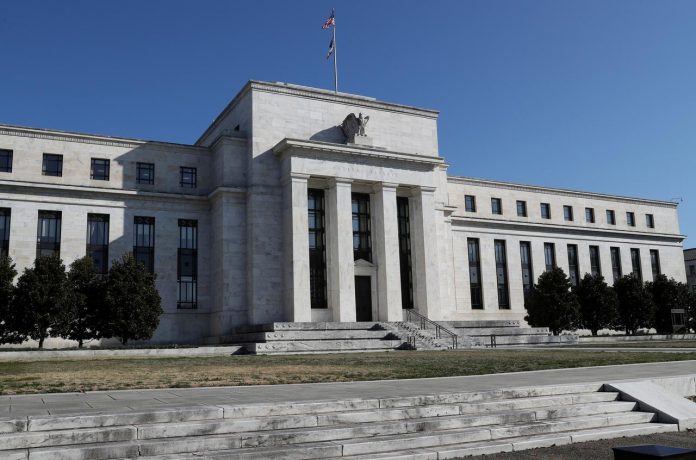Faced with a growing economic shutdown from the coronavirus pandemic, that could cause the US economy to contract, the US Federal Reserve on Sunday announced drastic emergency measures to shore up confidence and keep the financial sector running, including slashing the key interest rate to virtually zero.
The Fed made its second emergency rate cut in less than two weeks, lowering the benchmark borrowing rate to a range of 0-0.25 percent, where it was during the 2008 global financial crisis, and pledged to keep it there “until it is confident that the economy has weathered recent events.”
The central bank also announced massive asset purchases, opened its discount-lending windows to banks, making it easier for them to borrow from the Fed and urging them to use it to help businesses and households.
It also removed bank reserve requirements to allow them to use cash backstops to meet unexpected funding needs.
The Fed joined forces with other major central banks to guarantee the global financial system has enough cash to continue to operate.
President Donald Trump, who in the past has repeatedly berated the independent central bank for not acting more aggressively, praised the moves.
“What’s happened with the Fed is phenomenal news,” Trump said at a regular briefing of his coronavirus task force. “I can tell you, I’m very happy.”
The massive show of financial force, coming with more countries are on lockdown due to the spread of the COVID-19 illness, aims to contain the economic fallout as businesses are forced to shut their doors in an already sluggish global economy.
Even with these moves, Powell told reporters “the second quarter will be a weak quarter with probably output declining a bit.”
But “after that it becomes hard to say,” and “it’s going to depend again on the path of the virus,” Powell said in a call with reporters following the emergency meeting of the Fed’s policy-setting Federal Open Market Committee.
In joint action coordinated with the European Central Bank, Bank of England, Bank of Japan, Bank of Canada and the Swiss National Bank, the central banks moved to counteract global “dollar funding pressures,” Powell said.
“The swap lines are available standing facilities and serve as an important liquidity backstop to ease strains in global funding markets,” a joint statement from the central banks said.
While the Fed rolled out all of its weapons to support the economy, Powell said fiscal measures from the government will be “critical,” and applauded the measures being considered by Congress. “We hope they will be effective.”
Following its emergency meeting, the FOMC said “the coronavirus outbreak has harmed communities and disrupted economic activity in many countries, including the United States.”
The committee, which had been due to hold a regularly-scheduled two-day meeting starting Tuesday, vowed to “use its tools and act as appropriate to support the economy.”
Powell said the Fed still has some firepower left if the uncertainty is prolonged, but financial markets seemed uncertain: Wall Street plunged in futures trading, with the Dow Jones Industrial Average “mini” index losing more than 1,000 points or 4.5 percent, and the S&P 500 and Nasdaq posting similar declines.
Tokyo’s Nikkei stocks index also dropped slightly after opening.
– ‘Time is of the essence’ –
Former Bank of England board member Adam Posen told AFP central banks are showing they have learned the lessons from the last crisis: “Don’t wait for the data. Don’t save your ammo.”
But Posen, head of the Washington-based Peterson Institute for International Economics, said the nature of this shock, which affects demand not just financial markets, is different than the last crisis, and the Fed moves will not be sufficient without government spending.
“We have to be realistic that there’s a limit on what monetary policy can achieve in this environment,” he said, while praising the Fed’s signal to banks that they should not just sit on their cash.
In the wake of the global financial crisis, the bank regulators, including the Fed, required lending institutions to build up a large cash buffer in case of another emergency, so they would not require a government bailout.
The Fed decision on Sunday unleashed those reserves so bank can help support families and businesses, with more than $4 trillion at their disposal, and encouraged banks to make use of low-cost short-term loans from the central bank
“This action eliminates reserve requirements for thousands of depository institutions and will help to support lending to households and businesses,” the Fed said.
The Fed also revived the “quantitative easing” policy used during the last crisis that involves buying debt to keep money flowing through the economy. The Fed will in coming months buy $500 billion in US Treasury debt and $200 billion in mortgage-backed securities.
Economists praised the rapid and aggressive policy steps.
“We have been urging this action for some time and we’re very happy that the Fed did not wait until Wednesday’s meeting,” said Ian Shepherdson, chief economist at Pantheon Macroeconomics.












